Orongo
Orongo is on the edge to the Rano Kau extinct
volcano crater
, south of the capital Hanga Roa. The volcano
has steep cliffs and a small lake in its
crater that serves Hanga Roa with water.
It is 1km diameter and 280m deep.
This Orongo village consists of 54 houses
built from stone slabs, although their design
clearly evokes that of hare-vaka (boathouses),
common to the rest of the island.
It is believed to have been a ceremonial
centre from the 16th century, for the birdman cult and it was used for a few weeks of the year
in the spring. Island society left megalithism
as their ancestoral, political and religious
expression and replaced it for the cult to
the Make Make god, closely related to fertility,
spring and migratory seabirds.
Due to the spread of Christianity and the
illnesses brought by Europeans, less and
less locals used the site until it was finally
abandoned in the mid 19th century. Restoration work and studies have
been conducted in the 1970s and 1980s.
There used to be a basalt moai called Hoa Hakananai'a, that is now
on display in the British Museum. Unlike
other statues, this one is built from basalt,
the hardest material on the island.
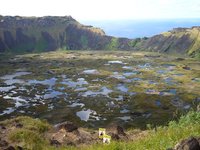 |
| Rano Kau volcano crater |
|
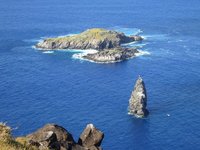 |
| Motu Nui |
|
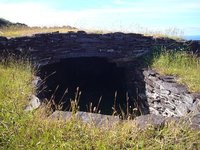 |
| Reconstructed house |
|
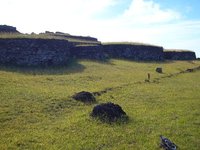 |
| The houses |
|
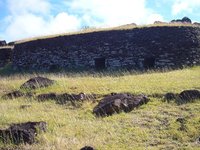 |
| The houses |
|
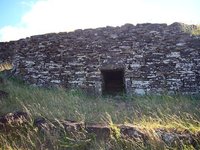 |
| House entrance |
|
PetrolglyphsSeveral thousands of petroglyphs can be found
on Easter Island. Most of them represent
animals, especially birds and the legendary
‘bird men’ (half man-half bird
mythological creatures).
The material used for making them was usually
volcanic rock with smooth surface. Most often
hardened lava and basalt. The petroglyphs
appear on large boulders located close to
the shore.
Tangata Manu, The Bird Man CultAlso called the "Manutara", this
was a ritual held once every year in the
spring. The birdman was seen as the representative
on earth of the creator god Makemake, and
eventually, this cult surpassed the traditional
power of the king
ariki
A representative from each tribe was chosen
by the leaders and was appointed to dive
into the ocean and swim to the islet of Motu
Nui. First, a gathering was held at the ceremonial
village of Orongo, then the selected members
set off and swam to Motu Nui in order to
collect the first egg laid by a Sooty Tern
bird.
The first swimmer to return to the main island
with an intact egg would secure control of
Easter Island's resources for his tribe
for the rest of the year. The winner was
then invested with the title of Tangata Manu and he then went down to Mataveri and from
there was led in procession to the southwest
exterior slope of Rano Raraku, where he remained
in seclusion for a year.
The task was dreadfully difficult and many
swimmers drowned or were devoured by sharks.
The last known Tangata Manu contest was held
in the 1800s.